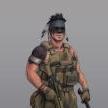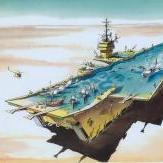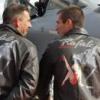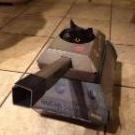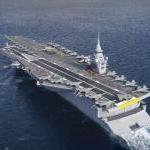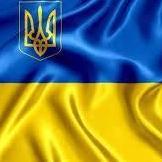Classement
Contenu populaire
Affichage du contenu avec la meilleure réputation le 09/08/2020 dans Messages
-
qu'il y ai des personne en 1974 a Chypre qui étaient turcophones et donc quasiment Turques, c'est indiscutable en quoi cela donne le droit a la Turquie d'envahir le pays ? Que diriont nous si demain l'Algérie décrété simplement que barbesse bas en faite c'est l'Algérie parce que il y a plein de descendant algériens ? Que la Turquie organise l'arrivé de turc pour prendre possession de la terre, cela s'appelle de la colonisation... 1 200 000 Chypriote contre 300 000 turcophone, dont 120 000 Turcs venant d'Anatolie depuis 1974. Moi je veux bien que l'on sois concilient... Mais faudrait pas pousser non plus, c'est une invasion. Les autochtones turcophone ne représente même pas 15% du total de la population, et faudrait leurs donnés 50 % de l'état fédéral ? Ce n'est clairement pas sérieux. A un moment faut savoir dire stop a la connerie...13 points
-
La rationalité d'Israël attaqué par tous mise en parallèle avec l'irrationalité de l'Iran... L'iran... Ah oui ce pays qui vivait peinard neutre jusqu'à ce que les Américains (et les Anglais) renversent le gouvernement démocratique pour mettre en place un gouvernement fantoche sanguinaire ? Et quand le pays a fait sa révolution (avec débordements) a subit quelques coups fourrés americain, avant de se prendre en pleine poire une attaque iraquienne avec adm (chimiques) soutenue par l'occident ? Ce pays qui vit sous sanctions américaines depuis 50 ans juste parce que ? Où un président americain peut se permettre de déchirer des accords de paix juste parce que ça lui chante, avant de menacer tout le monde de sanctions si tout le monde ne le suit pas ? Ce serait pas aussi le pays où des civils se font assassiner par des services secrets etrangers, des avec une ou plusieurs étoiles ? d'ailleurs les batiments non plus ne sont pas épargnés... Ni les programmes civils (et oui, qui maitrise le nucleaire civil maitrise le nucléaire militaire, qui maitrise le spatial maiyrise les missiles transcontinentaux, qui maitrise les brochettes de moutons maitrise aussi les rations de combats... Tout se suit)... Et alors on va où ? Bah si on exclut toute idée de solidarité face à " l'injustice" (je mets des guillemets parce que c'est ce mot est le leur) vécue par les peuple palestinien, il reste que l'ennemi americain est loin, alors que les proxy locaux, c'est à une portée de scud... Si je devais donner mon avis éclairé, que les americains arretent de faire chier les iraniens et ce serait déjà un petit pas vers la paix et la stabilité de la region (malheureusement pas une stabilité voulue par eux). Dans un second temps, qu'ils arrêtent de soutenir aveuglément israel, ce qui forcerait ce pays à essayer de s'intégrer dans le tissus régional qui est le sien.6 points
-
Pour Chypre, il faut rappeler le traité de garantie de 1960 , royaume uni Grèce et Turquie , qui autorise chacun des signataires à intervenir militairement pour restaurer l’equilibre constitutionnel si celui ci venait à être menacé, c’est ce qui s’est passé avec le coup d’etat du 15 juillet 74 et la tentative d’enosis, l’union avec la Grèce. de jure , l’intervention turque était justifiée, mais une fois la république et la constitution rétablit, les militaires turcs auraient dû plier bagages, quant à la colonisation elle est totalement illégale, tout comme l’etat fantoche crée à la suite la seule base de travail, est à mon sens la constitution de 1960 et le traité de garantie avec rapatriement des colons Anatoliens5 points
-
"Vous comprenez, gens tellement content voter pour président, gens parfois voter deux fois"4 points
-
[HS] Construction grammaticalement pleine de panache... mais l'imparfait du subjonctif du verbe être se contente d'un "qu'il fût" à la différence du "que tu fusses". Et ici on attendrait plutôt celui du verbe falloir Mais il y a plutôt une construction à base de conditionnel passé et donc une seconde forme pour rester dans l'esprit du post "Encore eût-il fallu que l'Europe ... existât" On note au passage la 3ème personne du singulier de l'imparfait du subjonctif du verbe exister avec son accent circonflexe qui le différencie du passé simple [/HS]4 points
-
Loukachenko élu avec 99% des votes, les autorités demandent à l'opposition de rester calme, que le résultat doit être affiné, il pourrait descendre jusqu'à 98% selon certaines sources sérieuses désireuses de garder l'anonymat.4 points
-
Si c'était si simple ... encore fusse t il que l'Europe - sous forme quelconque d'un état - existât ... et visiblement cela personne n'en veut. Pour le moment tout le monde se satisfait de faire parti d'un club étrange ou l'activité essentielle est de se tirer dans les pattes les uns les autres pour sortir ses marrons du feu - la sainte concurrence interne tout azimut mère de toutes les vertus bla bla bla -.4 points
-
Merci du tip ça fonctionne nickel! Pour la peine et parce que j'aime être mesquin, voilà le .pdf ré-exporté en non protégé pour que n'importe qui puisse piocher dedans et faire du copier-coller. C'est un document de 2018 mais il est intéressant parce que confirmant certaines pistes entreprises au début du FCAS franco-allemand. Source originale (protégé contre la copie) https://www.ifri.org/sites/default/files/atoms/files/noel_paglia_tenenbaum_armees_menaces_2018.pdf Fichier réexporté (non protégé contre la copie) https://www.mediafire.com/file/gufjg25lreqvq5e/noel_paglia_tenenbaum_armees_menaces_2018.pdf/file *** So, @DrSomnath999 here is the DeepL translate of the parts you wanted, with a few corrections here and there. I added some cross-translations for acronyms to make the whole thing easier to understand. After a bit of proof-reading, the text should make some sense at least (you can never be sure I've been told I wasn't capable of translating english recently, so I'm extra cautious now ). What impact for France? Limitations of the French SEAD model Like the White Papers on Defence and National Security of 2008 and 2013, the 2017 Strategic Review reaffirmed France's ambition to have the capacity to "go in first", i.e. to "penetrate these disputed areas and reduce the threat level in order to conduct military operations". In order to achieve this, it is imperative to upgrade capabilities for the reduction, neutralisation or destruction of enemy air defences (SEADs), a field that has been largely disinvested by France and its European partners since the end of the cold war, leading to major capability shortfalls. With the withdrawal of the AS-37 Martel from service in 1999, France no longer has any resources dedicated to SEAD. This loss of dedicated assets does not mean that the French Air Force is today unable to carry out such missions. A relatively original model based on a combination of survivability, precision strikes and tactical manoeuvres has enabled the French forces to ensure a form of "poor man's SEAD" that is sometimes innovative but whose sustainability in the face of a changing environment is open to doubt. The absence of anti-radar means and offensive jamming does not leave the pilot completely helpless in the face of ground-to-air defence. Low altitude flights, below the minimum threshold of the engagement radar and the use of terrain masks are usual methods that allow missions to be carried out within the theoretical envelope of a ground-to-air defence that would be devoid of air surveillance aircraft. Similarly, diversionary tactics exist to reduce the predictability of raid trajectories. Finally, signals intelligence allows the threat to be nuanced by indicating the inactivity of a ground-to-air system. During the operation in Libya, the French forces (combat aircraft and helicopters) thus sometimes decided to operate close to enemy ground-to-air systems considered inactive with regard to the Electronic Order of Battle (OdBE), a risk that their American counterparts would have refused to take. However, this risk-taking quickly reaches its limits when faced with integrated and multi-layered systems that make evasive manoeuvres extremely risky. The recent case of the destruction of an Israeli F-16I is an illustration: caught in the chase by 27 ground-to-air missiles fired by the Syrian air defence (SA-3, SA-5, SA-17), the crew chose to continue its mission, wrongly judging that it could avoid the threat. The propensity of the French model to take risks is partly reinforced by the attention paid to survivability. The latter is now based on the advanced measures of the Système de Protection et d'Évitement des Conduite de Tir du Rafale (SPECTRA). The electronic suite developed by Thales and MBDA operates on a combination of multispectral detectors (radar, laser and infrared) and countermeasures (defensive jammers with a wide active antenna, modular decoy launchers and intelligent Spiral chaff launchers). The ability of SPECTRA to ensure the survivability of the Rafale in the face of an advanced ground-to-air threat was debated. Indeed, while the echoes of exercises MACE XIII (2012) and MACE XIX (2018), which took place in Slovakia and during which the fighter and experimental squadrons (FETS) and electronic warfare programming and training squadrons (EPIGE) were able to rub shoulders with an S-300P (SA-10), seem to reveal the Rafale's good performance, caution is called for. First of all, the Slovakian SA-10 is a fairly old version that is not equivalent to an SA-20 or SA-21 such as those deployed by Russia in Syria or the Crimea. It should also be borne in mind that in joint exercises participants are often reluctant to show the full performance of their systems. In any case, it remains clear that despite its qualities SPECTRA is not intended to be an instrument for penetrating a sophisticated ADSL envelope and cannot offer a sustainable SEAD solution. In addition to self-protection, the French model has precision strike capabilities that allow, in the absence of SEAD, the destruction of air defence sites (DEAD). The most appropriate means of doing so, given its range, is the SCALP-EG cruise missile and its navalised version, the MdCN. Both, however, suffer from extremely small stocks which make it impossible to envisage an autonomous "first entry". Of the 500 SCALP-EGs ordered in the 2000s, only 250 are concerned by the mid-life refurbishment, suggesting that by 2025 there will be an extremely limited stock of ammunition for use against a SDAI (typically the 200 or so Tomahawks fired by the Americans in the first 24 hours of Operation Odyssey Dawn in Libya). This weakness would be partly compensated qualitatively by the superior accuracy of the SCALP-EG, which allows a smaller number of missiles to be fired at each target than the Tomahawk. Finally, the non-renovation of half of the SCALP-EG stock should be partly compensated for by the gradual arrival of the 200 billion CNN which finally came to equip the FREMM (with a baptism of fire in April 2018 off the coast of Syria) and should soon join the Suffren class SNAs. Finally, it should be recalled that cruise missiles are not the only precision strike means available to the French forces to deal with the ground-to-air threat. In particular, the Libyan experience has demonstrated the effectiveness of modular air-to-ground weaponry (AASM) against relatively old systems (SA-3 and SA-8). The latter is particularly effective when combined with SPECTRA, which detects, triangulates and refines the coordinates of the threat before transmitting them to the optronic front sector (OSF), which can guide the strike discreetly without switching on the RBE2 radar. Again, however, one must be careful not to conclude that this mode of action is feasible in the face of high-performance ADSI. The extension of the AASM is thus 70 km at high altitude and up to 20 km at low altitude, which would imply, depending on the flight profile, entering the SAM envelope - even when faced with short- or medium-range systems if we consider the most recent models (SA-17, SA-22, HQ-16, etc.). This brief table of French capabilities to deal with opposing surface-to-air defences shows that our armies are far from having a range of means guaranteeing them strategic autonomy for first-entry operations, even against a "second-tier" adversary with a relatively solid SDAI. The consequences of this capability shortfall are increased dependence on American assets, which could one day prove problematic as transatlantic disagreements multiply and the ground-to-air threat spreads to theatres where France used to act autonomously. In operational terms, failure to confront anti-aircraft threats would have dire consequences, obviously for air, naval and air combat forces, but also for all surface units, naval or land. Having long taken Western air superiority for granted, Western air forces have since adopted modes of action and even force models that make them largely dependent on it. Whether it be intelligence and surveillance missions, support for strategic (inter-theatre) or even tactical (intra-theatre) mobility, tactical communications, fire support and health support, naval and land forces are today structurally threatened by the modernisation and spread of surface-to-air systems. *** Air Force The air forces are logically the most directly concerned by the surface-to-air threat. With a view to increasing and sustaining the ability to enter first, it will be important to upgrade air superiority missions in general, and SEAD in particular, which should be at the forefront of the capabilities of the Future Air Combat System (FCAS). In this context, the development of a reduced SER combat UAV combining advanced manoeuvrability and data link capabilities should play a role in the penetration of high-performance SDAI. Such a system could have the function of acquiring targets within the surface-to-air threat envelope, retransmitting them to manned platforms at a safe distance. Another option would be to turn it into a fully-fledged strike system capable of carrying a sufficient quantity of ammunition in the hold. Before such a system is available, other more or less long-term steps can be taken by the air force. One of the first qualities of an air force is its level of training for a given type of mission or threat. However, even before mentioning the material shortcomings of SEAD, it has to be said that training in a degraded ground-to-air environment does not seem to be satisfactory within the French air force. The Franco-German Electronic Warfare Range (PGE) specifically dedicated to this type of mission is only equipped with a SA-8 system and SA-6 and ZSU 23/4 simulators, three threats that are now largely outdated. The disbanding in 2014 of the 48.530 Electronic Warfare Squadron, which was contributing to the PGE, was not good news in this respect. While a renovation of the PGE seems to have been initiated recently with a modest budget of $16 million from NATO funds, it would be appropriate to continue it with a view, for example, to acquiring certain Chinese or Russian ground-to-air systems from third countries, thereby using threat dissemination for the benefit of force preparation. In the longer term, the identification of a new training area (in mainland France or elsewhere) with dimensions large enough to accommodate real or simulated long-range systems would be a real added value for force preparation. Such a facility would have to be adapted to the organisation of large-scale complex (possibly combined) exercises to simulate a first-entry operation involving a number of different types of aircraft. Another key factor in the success of a mission to reduce ground-to-air defences is the availability of high-quality electronic intelligence (EOD) enabling a complete OdBE (Ordre de Bataille Electronique) of potential adversaries to be established in advance of an operation and the libraries of combat aircraft self-protection systems to be kept up to date. In this respect, the acquisition planned by the LPM of three strategic reconnaissance aircraft equipped with a universal electronic warfare charge (CUGE) must be top priorities for the French Air Force with a view to replacing the Gabriel C-160 Transall C-160s and the ASTAC pods adapted in 2016 for the Mirage 2000Ds. Similarly, the adaptation of a ROEM payload on Reaper and, eventually, on the EuroDrone MALE seems entirely appropriate, as the persistence of UAVs makes them particularly well suited to this collection function. The acquisition of a HALE UAV system could in this respect prove very useful for a strategic intelligence gathering capability at a safe distance. Once the operation is triggered, the need for ISR, not only radar but across the entire electromagnetic spectrum, will be even greater. It is thus estimated that the need for ISR is three times greater in the case of a first entry operation (30% versus 10% for operations in a more permissive environment). In addition to the strategic and tactical ROEM (Renseignement d'Origine Electro-Magnétique, SIGINT in english, SIGnal INTelligence) assets already mentioned, the implementation of SAR/GMTI sensors to detect dynamic targets are critical capabilities in the face of an increasingly mobile surface-to-air threat. Here again, UAVs should prove to be suitable platforms for carrying out these dangerous missions in a contested environment. Once the force has been trained and the information collected, the means must be available to strike surface-to-air systems. As described above, the French Air Force has several means at its disposal in this respect that should be modernised to meet France's stated ambition of a first-in-first-out capability. The revival of the production of the renovated SCALP-EG appears in this respect to be the most important point and probably the easiest to implement given the existence of the technology. As a second step, other measures can be taken, particularly in the face of the modernisation of short- and medium-range threats (SA-17, SA-22), consisting of further increasing the length of the AASM in order to sustain the DEAD capacity. In the longer term, research on hypervelocity, already initiated in the context of the renovation of the nuclear deterrent, should be continued and accelerated. The development and acquisition, even in small numbers, of hypersonic missiles should then profoundly call into question the dangerousness of ground-to-air interceptors. Finally, it would be legitimate to explore the advisability of developing an anti-radar missile, possibly based on existing armaments, such as the Meteor air-to-air missile, whose range, terminal guidance system and interoperability already correspond in part to the need. Another area to be explored for the air force concerns electronic attack means. While multiple PEA (Plan d'Étude Amont, or "upstream study plan") have been launched several times in the past with a view to developing an offensive jamming pod on Rafale, none of them have led to equipment programmes. In view of the know-how of French manufacturers in this area, and capitalising on the encouraging results of SPECTRA in terms of self-protection and the potential of the AESA RBE2, it would seem appropriate to look into such an opportunity, possibly jointly with European partners. Finally, the FCAS development framework should imperatively include a reflection on the acquisition of a saturation capacity for surface-to-air defences, in particular through the use of unmanned platforms. The aim here would be to regain a numerical advantage that the current balance between the small fleets of combat aircraft and munitions on the one hand and SAM systems on the other no longer allows. This approach would be based, among other things, on the use of air-launched mini-UAVs operating in collaboration with manned aircraft or in swarms from "mother ships" outside the SDAI bubble. The challenge is to maintain the UAV at a reasonable cost while providing it with sufficient capabilities (range, autonomous guidance, various types of decoy, GE or explosive payloads), which argues in favour of modular devices. These concepts, which have already inspired experiments such as DARPA's Gremlins, should be a source of inspiration for SCAF. In the shorter term, France could consider the off-the-shelf purchase of a fleet of ADM-160 MALDs. These consumable UAVs benefit from a SER augmentation system to simulate a fighter or bomber squadron in attack formation. Developed by Raytheon and ordered in more than 3,000 units by the US Air Force, this device would make it possible to saturate the radars, thus acting as a "smoke screen", or even exhaust enemy missile stocks. *** Hope you will enjoy! Cheers.4 points
-
Les Américains menacent de sanctionner le port de Sassnitz qui joue un rôle clé dans l'oléoduc Nordstream 2 https://www.sueddeutsche.de/wirtschaft/nord-stream-2-usa-sanktionen-sassnitz-1.4992413 (7 août 2020) Cependant, le port n'est pas en mains privées, mais il est détenu à 90 % par la ville de Sassnitz. Les dix pour cent restants sont détenus par le Land de Mecklembourg-Poméranie occidentale. Le port lui-même n'a pas voulu commenter la lettre vendredi. L'affaire releverait selon lui plutôt de la politique fédérale. Vendredi, le ministère de l'économie s'est une nouvelle fois opposé à toute forme de sanctions extraterritoriales. Celles-ci sont contraires au droit international, a expliqué une porte-parole. "En particulier dans la crise actuelle du coronavirus, il n'y a pas de temps pour enclencher la spirale de l'escalade et menacer de nouvelles sanctions". Niels Annen (SPD), ministre d'État au ministère des affaires étrangères, a insisté sur la souveraineté nationale dans le Tagesspiegel. "L'Europe ne doit pas se laisser faire du chantage", a-t-il déclaré. Le spécialiste Vert de la politique étrangère Jürgen Trittin a réagi avec indignation à l'action américaine. Il a qualifié cette étape de "déclaration de guerre économique". L'ancien ministre de l'environnement a déclaré à l'agence de presse allemande : "La mauvaise habitude des lettres de menace américaines aux entreprises allemandes est en train de prendre le dessus. Cette menace est illégale au regard du droit européen et international. "L'ingérence dans la souveraineté de l'Allemagne et de l'Union européenne a atteint un niveau d'agressivité sans précédent qui ne doit pas rester sans réponse", a déclaré M. Trittin. "Les entreprises impliquées dans ce projet ont besoin d'être protégées des méthodes du Far West de Washington". Il a souligné que le port de Sassnitz est situé dans la circonscription de la Chancelière Angela Merkel. "Il est difficile de comprendre comment elle entend expliquer son inaction continue aux travailleurs du port".4 points
-
Elle doit prendre l'échelle avec ses sacs de bulletins pour esquiver les observateurs indépendants qui stationnent dans le hall d'entrée.3 points
-
En faisant quelques suppositions, le calibre réduit et la balle plus allongée signifient un meilleur coefficient balistique et donc une meilleur rétention de vitesse à distance ainsi probablement qu'une meilleure trajectoire. Le 41 signifie qu'ils ont un peu allongé pour compenser un aspect (probablement la capacité en poudre requise pour une balle potentiellement plus lourde ou juste la recherche d'une meilleure vitesse à la bouche. La seule info un peu tangible que j'ai pu trouver se trouve sur le wiki polonais. Il décrit une vitesse à la bouche de 770m/s et une énergie de 2200J ce qui nous donne une balle de 7.42g (soit ~115gr). Impossible de connaître le coefficient balistique cependant mais c'est très probablement supérieur à celui de la 7.62×39 (pas difficile je sais). Sinon, j'ai cette photo de la balle Wiki polonias sur le Lantan: https://pl.wikipedia.org/wiki/Karabin_Lantan3 points
-
Raaaaaaaaaaaah ! Pas la peine de s'autoflageller pour ça Regarde moi : je suis la reine des langues de putes, et je le vis très bien ! Zéro culpabilité.3 points
-
Faut bien que je me fasse l'avocat du diable quand un troll t'explique que les palestiniens, qui déstabilisent les pays frontaliers, n'ont qu'a aller se relocaliser en Allemagne ... parce qu'en Palestine ils gènent, au Liban ils gênent, en Jordanie ils gênent etc.3 points
-
En peut revenir sur le contexte des années 70 et 80, le Liban est la principale base opérationnelle de l'OLP, le pays est déchiré par une guerre civile et l'armée syrienne occupe une partie du pays et des factions libanaises sollicitent une alliance avec Israël pour remporter la guerre civile tandis que d'autres sont alliées à la Syrie. Le gouvernement israélien de l'époque croit à tord qu'une des factions libanaise qui sollucite son alliance peut prendre le pouvoir si la Syrie et l'OLP était chassés et signer un accord de paix comme avec l'Égypte. Je ne vois rien de commun à la situation d'aujourd'hui. Aussi, tu suggéres que les libanais sont en guerre contre Israël pour les palestiniens. Il faudrait peut être organiser un référendum au Liban pour demander aux libanais s'ils veulent la guerre contre Israël pour libérer la Palestine. Je serais curieux de connaître les résultats. Dissoudre Israël et le remplacer par un état arabe-musulman, c'est créer 6 millions de réfugiés juifs. C'est marrant comment on présente le problème comme étant dû exclusivement aux descendants de réfugiés arabes en ignorant l'existence de descendants de réfugiés juifs du monde arabe. Je pense que dans l'imaginaire occidental, la condition de réfugié ou d'errant est plus ou moins naturelle aux juif, donc non problématique. C'est assez bizarre qu'à chaque débat sur le Moyen Orient sur ce forum il y en ai au moins un pour suggérer la dissolution d'Israël et c'est encore plus bizarre que ça vienne d'un modérateur.3 points
-
J'ai souvenir qu'ils y avait de superbes lotissements de luxe qui peinaient à trouver preneur en Turquie même : peut être une opportunité pour rapatrier quelques colons turcs ?3 points
-
Les colons ne sont pas tous les turcophones de l'île, mais les citoyens de la république turque envoyée sur l'île après 1974 pour occuper le terrain abandonné par les hellenophones chassés de chez eux par l'armée turque.3 points
-
En plus, l'objectif du nouveau pa est de pouvoir ramasser des avions EN MEME TEMPS qu'il en envoie. Il peut les envoyer depuis les catapultes de gauche ou celles de droites, au final le en même temps ne marche qu'avec celles de droites. Oué. Ça va bien le Macron. Sinon, pour la blague, depuis l'entrée en service du CDG, cite moi UN SEUL président qui n'a pas lancé d'étude sur un futur PA. un seul ! Bien pratique. On aime l'armée, on sait que c'est utile, il en faut deux, mais y'a du budget ça passe pas politiquement dans tous les bords, alors on annonce une étude et un futur choix pour les élections d'après et comme ça tout le monde il est content. Sauf la Marine qui voit passer les années... Les décennies même. Si y'a du sang basque, ça prend le pas sur tout le reste. Donc : basque. C'est comme ça qu'on a soumis les landais et les béarnais.3 points
-
En fait il s'agissait du BUREAU VERITAS civil (règlement édition 97 et mises à jour) pour la coque applicables aux navires de plus de 65 m ; avia , soute à munitions , intégration système de combat aux normes mili DGA ou DCNS , de mémoire à la signature du contrat BPC le BV mili n'était pas encore bouclé . en complément illustré Ceci étant dit ces navires ont été construits dans un cadre budgétaire très très serré , ils ont été remarquablement réussis dans ce cadre là .2 points
-
Compte tenu des activités récentes de Barkhane dans la région des 3 frontières juste à côté, je trouve étrange que cette zone de la bss ne soit pas strictement déconseillée aux touristes. Triste comme nouvelle.2 points
-
Dès que les Saoudiens font un truc, ça foire lamentablement. Ils ont dû faire un truc très sale collectivement dans une autre vie pour que le karma se venge à ce point.2 points
-
Un truc avec les politiciens de ce niveau, que j'ai appris avec le cas de son prédécesseur: savoir quel est son plan de reconversion post chancellerie. C'était un secret de Polichinelle, plusieurs années avant qu'il quitte le poste, que Schröder était déjà de facto embauché par Gazprom. Le temps des chefs d'Etat et de gouvernement prenant une retraite digne aux frais du contribuable (ne serait-ce que pour garantir contre les vilaines rumeurs et pratiques douteuses) et jouant les augustes patriciens et vieux sages qu'on consulte de temps en temps, est bien fini (on passera sous silence de menues pratiques de "consulting" tant que ça restait occasionnel). Tony Blair et Schröder, en Europe, n'étaient que les plus visibles de cette tendance devenue norme, de leaders ayant une carrière post politique très active et pleinement impliquée dans des groupes d'intérêts avec lesquels ils traitaient en politique, et par lesquels ils continuent à peser dans la conduite des affaires de leur pays. Et on s'arrangera pour que la presse n'en parle que très occasionnellement.2 points
-
Lorsque je fus accepté de travailler en Polynésie Française (1968-1972) pour mon entreprise de télécommunications (CIT - Alcatel), une longue enquête préliminaire fut diligenté à mon égard (par les Renseignements Généraux suivi d'un entretien avec un de ses officiers) pour l'obtention du "Secret N°2' du CEA (Commissariat à l’Énergie Atomique), division DAM (Division des Applications Militaire). Je travaillas directement sur le réseau numérique 'Information' et j''avais accès au PCT (Poste de Commandement et de Tirs ou était mon atelier), aux PEA (Points d'Essais Atomique) et sur la barge - Ballon ou était l'engin atomique/nucléaire à expérimenter Un avantage indirecte fut que nos passeports avaient le Visa Américain "Indefinelety" (durée indéterminée) en Juillet 1969 ce qui me fut bien utile par la suite en travaillant dans un groupe de la défense américain (Litton Precision Prodict).(1983 - 1994) en me rendant aux USA.. Pour Taverny et le travail concernant le matériel militaire au sein de ce groupe de télécommunications (STICAR, Fac-similé, RITA, matériel de télégraphie pour balises aérienne, etc., l'accréditation du "Secret Confidentiel N°2" fut utilisé pour me fournir l'accréditation militaire spécifiques aux Armées. Nous ignorions le nombre de personnes travaillant sur ce site. Lors de mon entrée au sein du groupe Litton, j'ai obtenu le même agrément pour travailler avec la défense Nationale (Lasers pour hélicoptères, magnétrons pour RADAR des appareils de l'Armée de l'Air, etc.). J'ai quitté CIT-Alcatel avec regret lors de restructuration du groupa pour le groupe Litton (meilleur salaire et ingénieur position cadre supérieur ou travaillait mon frère) ou je fus licencié après 11 années comme d'autre personnes car abandonné par le siège américain qui se fit condamné pour fraude financière (150.000 personnes dans le monde).2 points
-
ultime version du Nimrod il me semble. Comme pour les Harrier tout juste modernisé à grand frais les 2 avions sont passé à la case perte et (pas) profit. Du coup c'est les français qui ont du déployer des Atlantique2 en attendant les P8 incurie britanique...2 points
-
Le mécanisme de commerce avec l'Iran, difficilement mis en place, aura peut etre une occasion de servir en interne à l'UE. Pourvu que Trump fasse un second tour que l'Europe se défasse enfin de son carcan américain...2 points
-
2 points
-
Tout n'est pas à jeter. Le Sopwith Pup était mimi, le Hawker Hunter était un bijou, le Spitfire envoyait du bois, le Westland Whirlwind aurait pu rivaliser avec le Mosquito niveau élégance ! Mais tant d'échecs à côté ! On en parle du Fairey Gannet ?2 points
-
Je souhaite beaucoup de courage aux libanais avec tous les drames que le pays subit. Avec le potentiel humain de pays, il a tout pour être un des plus prospères de la region. En Israël, on s'inquiète beaucoup pour le port de Haïfa qui ressemble à bien des égards au port de Beyrouth: beaucoup d'entrepôts de matière dangereuse près d'une zone densement peuplées. Un des enseignements de la guerre de 2006 était qu'il fallait déplacer ces entrepôts loin des zones peuplées. Mais à part un grand entrepôt de nitrates d'ammonium qui avait été explicitement menacé par Nasrallah en 2016, ce projet traîne. J'espère que le drame libanais lui donnera un coup d'accélérateur.2 points
-
Je remonte le sujet avant qu'un Topol s'abatte sur le fil A330 que des pirates de l'air ont honteusement détourné en fil sur les AWACS Et j'en profite pour poster un brouillon d'article sur le remplacement des AWACS et ce qu'on pourrait faire coté français, c'est très spéculatif et je me demande si j'élag The backbone of NATO advanced early warning, the E-3 Sentry AWACS plane, is getting old. It first flew in 1975, and although it has been regularly upgraded over the years, it will eventually be impossible to maintain. NATO plans for a replacement in 2035, and although some NATO official are unimaginatively calling for an off-the-shelf purchase of some E-737 Wedgetail to replace it, the Wedgetail itself will be thirty years old at that point. So there is an need and an opportunity to think twice about what is expected of a future AWACS, and design or purchase one accordingly. Currently, AWACS fulfill two roles at the same time: They act as long-range radars, seeing beyond the horizon of the ground-based radars and beyond the range of the smaller radars on the fighters. They also carry electronic intelligence receivers. They are an airborne command post, coordinating the air operations around them, by vectoring fighter to intercept threats for instance. These roles could be split between two platforms, or even between a plane and a command post on the ground. However the latter would require satellites links to work on long distances, and satellites are vulnerable. So the radar and the command post will need to stay in line of sight if they are not on the same platform. For the airborne radar roles, a few more precise requirements can be drafted Future AWACS need to detect future threats at useful ranges. That sounds obvious, but in the context of air-to-air missiles having an increased range, the AWACS needs to stay further from the frontline. The Chinese are fielding a long-range PL-15 and are thought to be planning even longer-range missiles, either using quasi-ballistic missiles or ramjet propulsion. The Russian already have anti-AWACS long-range missile, the R-37, and might develop a new one. The threats are getting stealthier: all newly developed fighters incorporate some degree of stealth, and the same is true for cruise missiles. Faster threats have emerged, namely hypersonic cruise missiles and hypersonic glide vehicles. While ballistic early warning is traditionally the purview of large ground-based radars, the hypersonic projectiles fly within the atmosphere, so much lower than ballistic missiles. Consequently, the radar horizon of ground radars against them is shortened, and an airborne radar might prove useful to have a higher warning time. Some sample use scenarios are a good way to evaluate the relevance of candidate designs, as just laying down some quantitative requirements can miss some of the complexity of modern warfare. Here is one, from a French Air Force perspective: Raid escort is the most demanding mission for the Air Force, especially "first entry" raids on the first day of a conflict. The AWACS has to provide situational awareness of the enemy forces ahead of the raid, and manage the fight if necessary The nuclear raids are a special kind the Air Force trains a lot for in the Marathon and Poker exercises, and they typically include an AWACS, one or several tankers and Rafale fighters. They can last for up to 11 hours, for a 9000km/5000nm range. The objective is to deliver a ~500km-range nuclear missile on a defended target, which means defeating enemy combat air patrols that might be positioned in the way. Radar choice and integration There are a few different possible architectures for the radar integration onto the airframe. Long, flat phased-array antennas like on the Wedgetail below are aerodynamic and can be very large and tall, providing good angular resolution. They are very popular in recent Western AWACS design: However they cannot look directly forward and backward, as the beam can only be steered up to +-60° of the perpendicular to the antenna without incurring important losses, so another, much smaller radar has to be used for the front and back directions. This makes them ill-suited for raid escort, when the AWACS wants to see what is ahead. It could zig-zag +-30° to get the large antenna pointed in ahead of the raid, but that would slow it down by 15% and result in an intermittent coverage. Rotating antennas, like on the E-3 and E-2, do not have that problem. They can be combined with electronic scanning to focus on a particular sector, even stopping the rotation. The AN-APY-9 on the E-2D has the following modes: In ETS mode, the rotation of the antenna is stopped and the radar stares in a particular direction. Thus, more energy is put into that direction and the detection range increases. This can almost double the range, as seen on this datasheet for the ground-based Lockheed TPY-X search radar: Even though having a larger range than the distance to the radar horizon can seem useless, it also means that targets will produce stronger returns, making them more detectable. So it will increase the range against targets with small radar cross section (RCS), like stealth aircraft. There are other possible architectures, like having a fixed radome on top of the aircraft instead of a rotating ones, and putting three phased arrays inside. This gives slightly smaller arrays than with the rotating option, put is simpler mechanically and has a higher refresh rate. This is used on the Chinese KJ-2000: The triangle on the radome marks the position of the three arrays Finally, another option to put a forward-facing antenna is to put it in the leading edges of the wings, like the L-band array on the Su-57: Putting an array in each wing gives a very wide coverage of at least the frontal hemisphere: with a 30° wing sweep like on a commercial airliner, the +60° electronic steering gives a +-90° scannable volume. There is a downside though to using the wings: they are very thin, so the array cannot be tall, which means it cannot get information on the altitude of the objects it detects. On the Su-57, the wings are the only place where a wide L-band counterstealth array could be placed, so the designers accepted that tradeoff. Speaking of stealth, many countries are producing or developing stealth aircraft. As the Su-57 shows, they are no longer reserved to the US Air Force, so a future AWACS will have to be optimized to detect them. This means operating at low frequencies, where stealth shaping and radar-absorbent materials are less effective. Search radars usually operate in the low L band, between 1 and 2GHz, as it penetrates clouds and rain better. Interestingly, the AN/APS-145 on the E-2 operates in the low UHF band at 400MHz. The Russian ground-based Nebo RLM radars, which are optimized to detect stealth aircraft, operate in the VHF band at around 100MHz. The problem operating at lower frequency is that the angular resolution of the radar degrades, requiring a larger antenna to get back the resolution. This is a problem for 360° arrays carried above the aircraft: they cannot be too large as it would cause too much drag, reducing the range of the AWACS or even making it unstable. Interestingly, French radar manufacturer Thales is working on UHF radar with a focus on counterstealth applications, so it is a likely choice for a future French-designed AWACS, if such a thing were to happen: The UHF antenna on the vehicle above is interesting in that it is not filled: there is a wide space between the elements because they are half a wavelength apart, and the wavelength is large. So it might be possible to build an airborne forward-facing UHF array with little drag. With a UHF radar at 500MHz, the angular resolution will be four times poorer compared to a L-band radar at 2GHz. However, adding a high-frequency radar, for instance in X band at 10GHz, would allow to get back a good resolution: the X-band array would only operate in tracking mode and focus on the tracks detected by the lower frequency array instead of searching the whole sky. Thus, it can concentrate its energy on them. A X-band array using the full height of the radome would have 20 times the vertical resolution of the 500MHz array. That could be enough to get weapon-quality tracks from very far away, even against relatively stealthy targets, reducing the need for the fighters supported by the AWACS to use their own radars. As a rule of thumb, an X-band array with twice the diameter compared to a fighter's radar would have twice the range, for around four times the cost. Using higher frequencies also has a benefit for identification of contacts: the higher the frequency, the better the range resolution. At 10GHz, a radar with 10% of bandwidth has a range resolution of 15cm. It becomes 15m for a 100MHz VHF radar with 10% of bandwidth. Range resolution is interesting because it gives an estimate of the size of a contact. For instance, if contact has measures 50m in the range direction, it is not a fighter. However, with only range information, it is not possible to make a precise contact classification. To do so, a synthetic aperture radar (SAR) mode is needed. SAR is commonly used to image the ground, or to classify surface contacts with the more advanced ISAR mode: Frigate imaged in ISAR mode by a Thales Searchmaster surface search radar In SAR modes, a 2D picture of the target is built. The higher the radar frequency, the better the resolution of the picture, so it is a good reason to operate in X-band. Now, there are no radar manufacturers that I am aware of that advertize air-to-air SAR mode, but that does not mean it is not implemented. Indeed, there are scientific articles on air contact ISAR imaging, demonstrating the feasibility. The challenge is that the target can move more quickly and in more direction that surface contacts. X-band air-to-air ISAR image of a Beechcraft 90 High-resolution surface-to-air ISAR With ISAR, the length, wingspan and number of engines of contacts can be determined, so it becomes possible to classify targets at long ranges, even in bad weather. Adding an X-band radar would also open interesting possibilities of bistatic radar operations: since the fighters' radars operate in the same band, they can act as receiver for the signal coming from the AWACS, without emitting themselves. That way, they stay stealthy, and since they are closer to the target, they get a stronger return from it than the AWACS does. Platform To minimize cost, the platform will likely be derived from a commercial aircraft. Business jets are a possibility for a side-looking architecture. To get back to an hypothetical French-designed solution, the Dassault 8X has already been selected by the French Air Force for its next-gen ELINT planes, and is slightly smaller than the Gulfstream G550 used for the Israeli AWACS. The future Archange ELINT collector Another option is to use an Airbus plane. A Neo version of the A320, such as the A321XLR, could be an option. At 101t maximum take-off weight, it would be slightly heavier than the baseline Boeing 737-700 used for the Wedgetail. With its operational radius of 2300nm, it is a good fit for the 11-hours, 5000 nm missions which the Air Force is fond of. It would only need one partial refuelling. To avoid taxing tankers too much, the heavier A330 airframe could be used. The A330 is the basis for the MRTT tanker which is in service in the French Air Force, so using it would bring some commonality to the two platforms, hopefully reducing cost. The MRTT is based on the A330-200, which has been reengined into the A330-800. The latter has a 4000nm operational radius. At a list price of 250M$, it is twice the price of an A321 though, and the range far exceeds what is need for long-range raids. It would have a very long on-station time but would probably need two crews to make full use of it. So it is oversized and the A321 is a better fit.2 points
-
C'est une région "orange", c'est à dire fortement déconseillée sans raison impérative. Le tourisme n'est pas à ma connaissance une raison impérative, donc ces gens ont pris des risques inconsidérés, qu'ils ont malheureusement payés cher. J'espère que Barkhane retrouvera les coupables et leur rendra la monnaie de leur pièce.1 point
-
Je ne sais pas, est ce que le libanais moyen sait que les interventions israéliennes au Liban ont été cautionnés et même sollicités par un des principaux protagonistes libanais de la guerre civile? Si c'était aussi illégitime, la moitié de la classe politique chrétienne devrait être en prison pour trahison. Même les autres protagonistes musulmans de la guerre civile (Amal et le PSP) n'ont pas tiré une balle contre l'armée israélienne tant qu'elle tapait sur l'OLP puis une fois Israël parti de Beyrouth, ils ont empêché l'OLP de revenir par les armes. C'est un peu hypocrite d'avoir fait faire un sale boulot que la moitié des libanais voulait faire aux israéliens puis de leur reprocher leur horrible agression gratuite. Israël a un grand tort dans cette histoire, celle de s'être mêlé d'une guerre civile et d'une lutte pour un partage de pouvoir qui n'aurait jamais dû le concerner.1 point
-
En clair la solution de sortie de crise pour toi, serais que les chypriotes grec acceptent sans broncher le chantage turc en s'appuyant sur l'exemple israélien. Magique !!!!!!! Erdogan condamnant régulièrement les colonies israéliennes en terre palestinienne mais faisant de même sur Chypre.... Mais visiblement quand c'est la Turquie c'est moins condamnable que Israël ou les Blancs au Sud-af ??? D'ailleurs le Sud africains blanc sont un très bon exemple de retour au pays "d'origine"1 point
-
Personne ne pense ici qu'il s'agit de "pousser les juifs à la mer", pas plus que les réfugiés palestiniens et leur descendants ne s'évaporeront par l'opération du saint esprit. Tu es intelligent, tu as parfaitement compris que l'absurde répondait à l'absurde. Mais tu as décidé de déplacer le débat. Je vois ton passage sur la qualité de modérateur comme une tentative d'interdire toute forme de débat. C'est moyen. Enfin, je ne me sens pas concerné par "l'imaginaire occidental" du refugié juif ou arabe. D'ailleurs, c'est peut-être un appriori. Tu as le droit de dire tout le fond de ta pensée mais pas de prêter des intentions aux intervenants ni d'instrumentaliser les débats. Le sujet régional est déjà assez complexe pour que personne ne verse dans le grand n'importe quoi. Sinon heureux de te lire, ça faisait un moment!1 point
-
En parlant de ça, le tribunal international sur l'attentat contre Hariri, dont le Hezbollah est le principal suspect, doit rendre bientôt son verdict.1 point
-
Crâne d'un soldat romain qui est mort pendant les guerres des Gaules, 1er siècle avant Jésus-Christ. Museo Rocsen en Argentine. « Je ne suis pas expert mais je crois savoir la cause de sa mort. »1 point
-
1 point
-
Parce que la France a dans sa constitution des frontières définies ? Otez moi d’un doute ! La Libye n’est pas dans le grand Israël. A moins que Israël ne se revendique héritier de Tyr, Sidon, et Carthage. Pour revenir sur la question libanaise.1 point
-
Ça c'est sur que si tout le PO s'auto-dissout ça règle les problèmes d’Israël Le problème des pays frontaliers d’Israël ce sont les millions de réfugié palestiniens ... il suffirait de dissoudre Israël pour régler leur problème. Retour des réfugiers ... plus de souci d'invasion ou de bombardement ...1 point
-
Contre quoi exactement le Hezbollah résiste-t-il aujourd’hui ? L’occupation de quelques fermes par Tsahal ? Deuxième question : le Hezbollah est-il prêt à reconnaître l’Etat d’Israel dans le cadre d’un règlement de paix ? Troisième question : comment le Hezbollah s’auto-finance s’il est si peu corrompu que cela ? Lève -t-il des impôts ? Quatrième question : quel type de gouvernement peut tolérer sur son sol une armée privée aux ordres d’un parti politique ?1 point
-
Il y a une multitude de variantes de cette plaisanterie suivant les écoles, il me semble qu'à l'origine c'était ça: Quelle est la différence entre un Polytechnicien, un Centralien et un ingénieur des Arts et Métiers? Le Polytechnicien construit un pont, le pont s'écroule, le Polytechnicien sait pourquoi. Le Centralien construit son pont, le pont s'écroule, mais le Centralien ne sait pas pourquoi. L'ingénieur des Arts et Métiers construit son pont, le pont tient mais l'ingénieur ne sait pas pourquoi. Sinon quelle est la différence entre un Polytechnicien et un train?1 point
-
Oui Kiriyama. Je fus en charge de l'élaboration en plate forme de contrôle,, de présentation en recette auprès du client et de l'installation du premier équipement à Taverny. Ce fut ma première "Grosse affaire" en tant qu’électronicien du fait que j'avais déjà à cette époque une formation numérique acquise par cours du soir et une expérience de responsable numérique au CEP (Centre d'Essai du Pacifique). Ce site était immense et nous nous déplacions en voitures dans les galeries souterraines. A intervalle régulier, il y avait des salles de travail et des "bunkers anti-nucléaire" de part et d'autre ainsi que des séparations de galerie. Le poste de garde d'entré de la galerie principale était severement gardé avec chiens et fouille des véhicules et parfois des personnes. Il fallait une accréditation pour se présenter à l'entrée.1 point
-
Ce qu'il y a de bien avec "l'implication étrangère" c'est que çà permet de passer sous silence l'incurie libanaise ... La bonne vieille méthode du bouc émissaire1 point
-
si tu fais allusion aux M2/10 je rappelle qu'ils n'ont pas volé durant presque 10 ans1 point
-
1 point
-
Le hezb quoi qu'il en dise est complètement mouillé dans le système clientéliste libanais, certes moins que Amal, Jumblatt, Hariri and co mais partis prenante tout de même. par ailleurs tout le problème est de changer le système sans provoquer une nouvelle guerre civile. Seul une intervention étrangére pourrait régler le probléme mais les étrangers sont rivaux entre eux et pas toujours les amis des libanais... D'où un statu quo fragile que personne ne veut remettre en cause sauf la rue...1 point
-
Vu la prise de RETEX des 9 dernières années, le Hezbollah peut-il être encore qualifié de milice ? Il me semble que nous avons là un niveau d'organisation et de préparation opérationnelle digne d'une véritable armée.1 point
-
1 point
-
1 point
-
On propose par pure charité chrétienne de rééquiper l'USAF en A330 MRTT et en Rafale histoire d'avoir un semblant de crédibilité face à la Chine...1 point
-
Les postes manuels il faut du monde pour les servir il faut du monde pour relever les mecs de quart au 20 mm dans les eaux resérées. Et du monde on en a plus surtout si les PO passent eux aussi à 2 equipages 2 MecS de quart au CO ilS te commandeNT les 2 Narwal le 40 mm, les MMP et le simbd RC. En plus avec les optiques ils voient plus loin que les autres dehors. Et en cas de tir adverse il vaut mieux etre dedans que dehors. C'est fini le temps ou tu mets 6 mecs autour d'un 40 bofors et 4 autour d'un 20mm1 point
-
@Tancrède Assez parlant en mode humour, je pense qu'elle va te parler cette vidéo . https://youtu.be/bQPtWrK145w1 point
